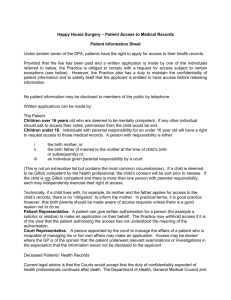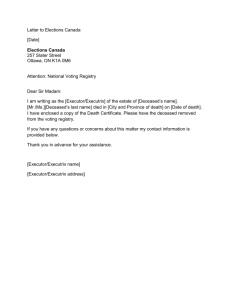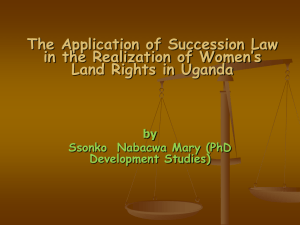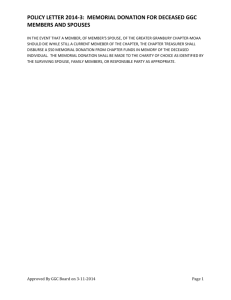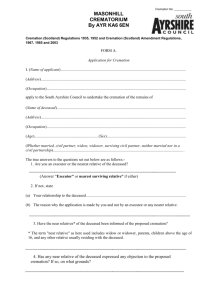high-court-2010-1
advertisement
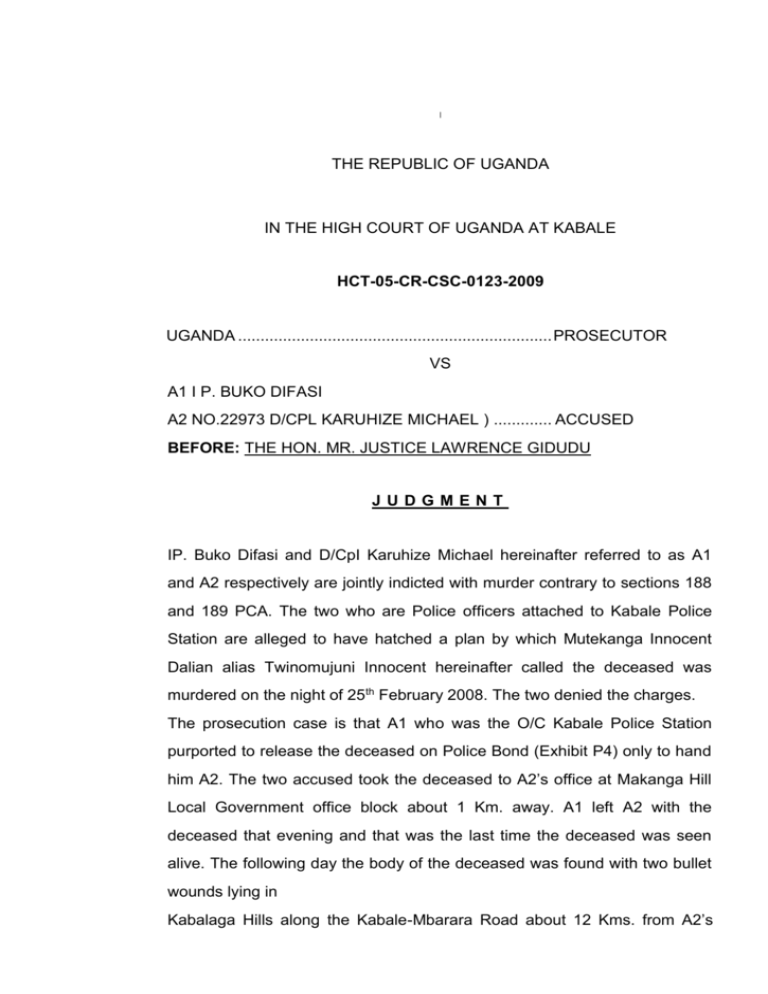
I THE REPUBLIC OF UGANDA IN THE HIGH COURT OF UGANDA AT KABALE HCT-05-CR-CSC-0123-2009 UGANDA ...................................................................... PROSECUTOR VS A1 I P. BUKO DIFASI A2 NO.22973 D/CPL KARUHIZE MICHAEL ) ............. ACCUSED BEFORE: THE HON. MR. JUSTICE LAWRENCE GIDUDU JUDGMENT IP. Buko Difasi and D/CpI Karuhize Michael hereinafter referred to as A1 and A2 respectively are jointly indicted with murder contrary to sections 188 and 189 PCA. The two who are Police officers attached to Kabale Police Station are alleged to have hatched a plan by which Mutekanga Innocent Dalian alias Twinomujuni Innocent hereinafter called the deceased was murdered on the night of 25th February 2008. The two denied the charges. The prosecution case is that A1 who was the O/C Kabale Police Station purported to release the deceased on Police Bond (Exhibit P4) only to hand him A2. The two accused took the deceased to A2’s office at Makanga Hill Local Government office block about 1 Km. away. A1 left A2 with the deceased that evening and that was the last time the deceased was seen alive. The following day the body of the deceased was found with two bullet wounds lying in Kabalaga Hills along the Kabale-Mbarara Road about 12 Kms. from A2’s office. Each of the accused person denied participating in the murder of the deceased. A1 testified that he released the deceased on Police Bond and by coincidence; A2 intercepted the deceased before he left the Police compound. A2 wanted to interrogate the deceased on matters of National security. A 2 requested A1 to give him transport to take the deceased to his (A2’s) office located 1 Km. away. A1 obliged but went along with the party because he wanted to solicit for fuel from the Local Government administrators for the Police patrol vehicle. A1 left both A2 and the deceased behind and went back to his home. He has no knowledge of what followed. A2 on his part stated that after interviewing or interrogating the deceased, he released him just before 5.00 p.m. and went to his home where he arrived at 7.00 p.m. and never left till the following day. The defence called Karema Charles (DW4) who testified that he saw the deceased in Kabale town walking freely at 8.00 p.m. on that day. Once the accused deny the offence, the burden rests upon the prosecution throughout the trial to prove the case against the accused. Each of the accused has no duty to prove their innocence. The burden must be discharged beyond reasonable doubt. Woolminaton vs DPP (1935) AC. 462 and Sekitoleko vs Uganda [1967] EA 531 followed. On the indictment for murder, the prosecution is required to prove the following essential ingredients beyond reasonable doubt: (i) That the deceased is dead (ii) That the death was unlawful (iii) That death was caused with malice aforethought (iv) That the accused participated. At the conclusion of the trial and during their final submission to court, both defence counsel did not contest the first 3 ingredients stated above. The evidence of Dr. Karugaba (PW1), Muhereza Dastan (PW3), D/AIP Tumwesigye (PW4), Muhereza Nastori (PW7) and that of Sunday Amos (PW8) when read together puts the matter beyond doubt that the deceased is dead, he died of two bullet wounds through the left side of his chest and his body was found lying in a bush in Kabalaga hills. Homicide unless accidental is always unlawful except in circumstances which make it excusable. This was not a case of suicide nor was the deceased’s death authorized by law. The deceased was murdered and disposed of in a bush. His death was unlawful and whoever shot those lethal bullets that tore the cardiac muscle and the left lung leading to irreversible haemorrhagic shock and excessive bleeding had the intention to cause instant death and must have acted with malice aforethought. PW1’s evidence shows that the bullets were clinical and aimed shots at the area housing the heart and lungs. Those are vulnerable areas that gave the deceased no chance to escape death. I find that the first 3 ingredients have been proved beyond reasonable doubt. The only issue that was contested is the participation of the accused in the murder of the deceased. The prosecution invited court to hold the two accused liable as principal offenders under sections 19 and 20 PCA. That the accused master planned the murder and disposed off the deceased in concert with others at large. Relying on circumstantial evidence, the prosecution asked me to consider the following circumstances and find that the accused participated in the murder. (i) Deceased arrested after a phone call from a civilian (ii) Deceased detained for five days without proper charge (iii) Deceased released in dramatic fashion by A1 who was not the O/C CID. (iv) A2 appears at the Police Station and A1 provides transport to take deceased to A2’s office (v) (vi) The deceased is found dead the following morning Deceased was last seen alive in A2’s office. The defence disagreed and contended that circumstantial evidence was not strong enough to make the accused culpable. That there could have been intervening circumstances whereby the deceased, a known notorious thug who had been in and out of prison could have been bumped off by other aggrieved persons. Further that the alibi of each of the accused excludes them from being culpable since both were in their homes for that night when the deceased was killed. There is no doubt that the prosecution case is entirely based on circumstantial evidence. That is evidence of the surrounding circumstances, such evidence must:(a) produce moral certainty to the exclusion of all reasonable doubt; (b) be inconsistent with the innocence of the accused; (c) be incapable of explanation on any other reasonable hypothesis than that of guilt; (d) be such that the inculpatory facts are incompatible with the innocence of the accused; (e) lead to the irresistible inference that the accused committed the crime. See 1. Uganda vs Leo Mubvazita & 2 others (1972)2 ULR 3. 2. Charles Kayemba vs Uganda [1985] HCB 9. 3. Uganda \/s Albino Aiok [19741 HCB 176. It is not in dispute that the deceased was in Police custody and was released from custody by A1 but before the deceased could leave the station, A2 arrived and A1 provided transport that took them to A2’s office. That was the last time the deceased was seen alive. The following morning he was dead. In view of this undisputed fact, let me examine why and how the deceased was arrested. Kamugisha Keneth, PW5, a bar owner in Kabale testified that he had information that whoever saw the deceased should inform the District Internal Security officer so that he is arrested. That the deceased was a common thief or robber and used to steal chicken from PW5. On 20/2/2009, the deceased entered PW5’s bar and he promptly called/rang D/C Habomugisha (PW6) who came and arrested the deceased. PW6 was not the DISO but confirms arresting the deceased from PW5’s bar. The prosecution faulted this arrest originated by a phone call from a civilian to arrest the deceased without a charge pending at the Police. It is my view, that the original arrest was illegal and an abuse of the Police powers of arrest. There was no pending case against the deceased at Kabale Police nor had the deceased committed any offence in PW5’s bar that night. I shall draw a conclusion on this arrest after discussing other aspects of this case. On the fateful day 25/2/2008, it was PW6’s evidence that A1 instructed him and D/C Mubangizi to release the deceased who had overstayed in the cells. That Police Bond forms were prepared, taken to A1 for signature and PW6 took the deceased to the counter to sign for his possessions and that the two (PW6 and D/C Mubangizi) left the deceased at the counter and went away. I would not believe such evidence where Police officers leave a suspect at the counter and walk away even if he is on bond. It would be the other way round for the suspect released on bond to leave the counter and go away leaving the Police officers behind since they are on duty. I am fortified in my disbelief of this part of PW6’s evidence because of the evidence of SPC Sunday Amos (PW8) who testified that at about 6.00 p.m., A1 called him to his office and inside that office was a man (suspect) who was later handcuffed by A2, the Police driver was summoned at about 6.0 p.m. and drove the suspect, A1, A2 and PW8 to Mabaga hill. PW8 escorted the suspect to A2’s office and returned to the vehicle where PW9 remained at the steering wheel. PW6 was thus lying where the deceased was left. The logical conclusion is that at all material times, the deceased was in the constructive detention of A1 until A2 took over. Similarly, A1’s testimony that once he signed the Police bond, he left the deceased in the hands of the constables to give him his property to go is a lie. The time frame the two accused rested their defence is against the weight of evidence by SPC Sunday (PW8) and PW9 the Police driver plus that of PW10 the DISO who all place the events of this case to have happened after 6.00 p.m. Musimenta Obadia, PW10, the then DISO of Kabale went to his office at about 6.00 p.m. and found a Police vehicle driven by PW9 parked at the administration block on which A2 had an office. PW9 confirms seeing PW10. The DISO (PW10) left shortly and still left the Police vehicle behind. If A1 had released the deceased on bond at 3.00 p.m. and A2 had released him after interrogating him just before 5.00 p.m., then PW 10 would not have seen PW9 waiting to take back A1. Similarly, PW8 who had worked and booked out at Mwanjari Police Post before he arrived at Kabale police Station at about 6.0 p.m. would not have seen the deceased since both accused would have released him before 5.00 p.m. The time frames given by the defence are a naked lie and raises more questions than provides.. Was it a coincidence that A2, who had known the deceased as a notorious thug in Kabale arrived at the Police Station and according to A1, he intercepted the deceased to interrogate him on matters of national security? It was thus a pre-arranged plot to eliminate the deceased reputed to be a notorious thug in Kabale. Having discussed the time frames given by the defence, I would not labour this issue any further. Whatever was being done, was pre-arranged and moved according to plan. The release of the deceased on the purported Police bond was as dramatic as his arrest by a mere phone call by a bar owner to a Police officer (PW6) who was not even on duty but was in his house in the police barracks. No charges were preferred save for rumours that the deceased had stolen money in Kisoro but Kisoro Police had not sought assistance from Kabale Police to arrest the suspect. Similarly the alleged counterfeit notes which were the basis of his detention and bond appear to have been mere imaginations. This is so because the deceased would have been charged in court on a holding charge as the Police verify from experts whether the notes were counterfeit or not. The whole arrest, detention and subsequent disposal of the deceased was illegal. Finally, having faulted the process that brought the deceased into the hands of A1 and subsequently A2, did the accused participate or procure the murder of the deceased? I was asked by the prosecution to find that the logical conclusion of the accused’s sinister plan was to bump off the deceased while the defence case is that the deceased met his own death independent of each of the accused who were sleeping in their own houses. A1 had released him at 3.00 p.m. while A2 had released him at 5.00 p.m. I have already discussed these time frames in my earlier part of this judgment. I shall, however, examine the alibi by each accused. It is trite law that an accused who sets up an alibi which is technically a defence has no duty to prove it. The prosecution must negative the alibi by evidence. In other words, the burden of proving an alibi does not lie on the accused. Uganda vs D. Sabuni [1981] HCB 1 and Sekitoleko vs Uganda (Supra) followed. In the instant case, the prosecution case is not that the accused were positively at the scene of crime and so did not labour to place the accused at the scene by direct evidence but contend that by circumstantial evidence which is manifested in the conduct of both A1 and A2, the two, with others at large, caused the deceased’s death because the deceased was found dead a few hours after he was last seen alive in the custody of both A1 and The defence case is that the deceased who was a known criminal and who had been in and out of Police cells could have met his death at the hands of those he had offended or robbed. That DW4 saw him walking freely in town at about 8.00 p.m. which means he was not in custody of A1 and A2. Circumstantial evidence is very often the best evidence. It is evidence of surrounding circumstances which, by intensified examination is capable of proving a proposition with the accuracy of mathematics. It is no derogation of evidence to say that it is circumstantial. See R vs Taylor Wear and Donoran (1928) 21CR. ADD. R. 20 quoted in Tumuheirwe vs Uganda [1967] 1EA 328. However, as Lord Normand noted in Teper vs R (1952) AC. 489, Circumstantial evidence may be fabricated to cast suspicion on another and it is necessary before drawing the inference of the accused’s guilt to be sure that there are no other existing circumstances which would weaken or destroy the inference. In the instant case, the accused do not deny being in contact with the deceased although they give a time frame that I have found to be false in view of the evidence adduced by PW8, PW9 and PW10. By the accused’s alibi, they do not know what followed or how the deceased met his death. The prosecution contends that the accused disposed of the deceased to the killers and are criminally liable under sections 19 and 20 PCA. I have already found that the arrest, detention and purported release on bond were all stage managed and is tainted with criminality and abuse of powers of the Police to arrest citizens. In view of this background, the release of the deceased is clouded in a mystery only known to A1 and A2. The evidence of DW4 was very casual about meeting the deceased in town at 8.00 p.m. and is unbelievable for lack of a proper background to that meeting. I have no doubt in my mind that the person who killed the deceased did not find him roaming on the streets of Kabale or along a village path. The killers must have got the deceased from the hands of A2 who himself had got the deceased from the hands of A1 as part of a bigger plan to eliminate what the two Police officers believed was a reputed criminal in society. The time when the deceased was last in the hands of the accused and the time when he was found dead was in the circumstances of this case so short as to reasonably attribute his death to the design and plot of the two accused persons acting in concert with the common intention to prosecute an unlawful purpose. Under S. 19 PCA, each party is an agent of the others in carrying out the object of the conspiracy and in doing anything in furtherance of the common design renders himself a principal offender. See Charles Komuswa us Uganda [1979] HCB 86. In view of the testimonies of some prosecution witnesses and the statement of A2 in his defence regarding the notorious character of the deceased, I am inclined to consider motive in the murder of the deceased. In law motive is irrelevant in a criminal prosecution but becomes useful since a person in his normal faculties would not commit a crime without a reason or motive. The existence of a motive made it more likely that the accused did commit the offence charged. See Tinkamalirwa & another vs Uganda [1988-90] HCB 5. PW5 who rang PW6 to arrest the deceased stated that the deceased whom he had known for 2 years was a notorious thief who had even stolen his chicken. That news of his death gave him relief. Muhereza Nastori, PW7, who is a brother to the deceased admitted that the deceased had been to prison on 3 other occasions. PW10 who was the then DISO of Kabale testified that he got information that the dead man was a notorious criminal called Dallas who used to cut people in town. He went on to say LCS had always complained that the deceased used to kill people and A2 in his statement stated that he knew Mutekanga Innocent as the most feared notorious thug in Kabale. These statements about the character of the deceased show that the accused as Police officers had the motivation in concert with others in the security circles to eliminate the deceased believed to be a thug by the community. To this extent motive is a relevant consideration in this case. The accumulated import of the manner in which the deceased was arrested, the conduct of A1 and A2 in the purported release of the deceased and the motive to bump him off coupled with the short space of time before the deceased’s body is found riddled with lethal bullets when considered together and not in isolation, lead to the irresistible inference that the two and others at large murdered the deceased. The two provided the master plan and handed out the deceased to his killers. This was one common design to prosecute an unlawful purpose. This renders the accused persons principal offenders under Section 19 PCA. I did not find it necessary to consider the defence submissions about inconsistencies whether the deceased was handcuffed or not and whether the Police car is a double cabin or not because the accused do not deny taking he deceased to A2’ office. Similarly arguments that the prosecution did not place the accused at the scene were, with respect, not relevant because the prosecution case is entirely based on circumstantial evidence and not direct evidence. Similarly, the alibi is useful if the prosecution case is that the accused physically pulled the trigger. The case for the prosecution is that the two accused hatched the plan and availed the deceased to the eventual killers. The death could have occurred as the two accused slept in their beds but they had finished their roles before retiring to bed and are criminal liable as principal offenders for having been part of conspiracy and common design to murder the reputed criminal Dallas. For these reasons, the circumstantial evidence against the accused persons is so strong that it is inconsistent with the innocence of the accused and incapable of any other explanation than that of guilt. The two did not act innocently but in pursuance of a clearly laid plan to murder the deceased. I am in agreement with the lady and gentleman assessors that the prosecution has proved the case against each accused beyond reasonable doubt. Each of the accused is guilty of murder contrary to sections 188 and 189 PCA and I convict each of them accordingly. Lawrence Gidudu Judge 1801/2010 81/01/2010 Accused in dock Bikangiso for accused Ngaruye for accused absent Kalinaki for state Turyamubona - English/Rukiga Court Judgment read in open court. Allocutus Pros: No previous record. A1 appeared in court 3/12/2008 A2 was produced on 10/12/2008. They have been on remand for one year and one month. The offence attracts the maximum death sentence. The two are Police officers mandated to protect lives and property of people. They instead took away life extra- judicially. They acted with impunity. I apply for a maximum sentence to warn other security personnel that they cannot kill with impunity. Bikanqiso: Convicts are first offenders who have been on remand for a year and a month. They have families to look after. They are remorseful. Maximum sentences do not teach convicts any lessons. Death does not teach anything so the dead convict. My father is sick and my children admitted in hospital. I have got saved while in prison. I request for a lesser punishment. A2: I agree with defence counsel, I have young children who need my care - I received Jesus as my savior. I am now a changed man. I pray for a punishment that gives my family hope of meeting them. Reasons & Sentence I have listened to both the prosecution and defence in the allocutus. The prosecution calls for a maximum sentence to send a strong signal to security officers about acting with impunity in killing suspects. The defence calls for lenience and the convicts each have stated they are changed persons. I am mindful of the fact that from the evidence on record by both the prosecution and defence, the deceased was such a notorious thug whose demise brought relief to the community of Kabale. Unfortunately, it was illegal to kill him extra-judicially. Since he was a known thug, he could have been charged with several offences and could have been convicted without extra judicial methods being employed. The two Police officers took the law into their hands and killed a person who had not been proved guilty by the Courts of law. For this reason they shall take the punishment. Doing the best I can, I do not think that a death sentence should be handed to the accused. I shall impose a custodial sentence which is however long enough to warn other Police officers that they have no right to kill suspects. I sentence each of the accused persons to 14 years’ (Fourteen years) in prison. Judge 18/01/2010 Court: R/A against conviction and sentence in 14 days explained. Judge 18/01/2010




